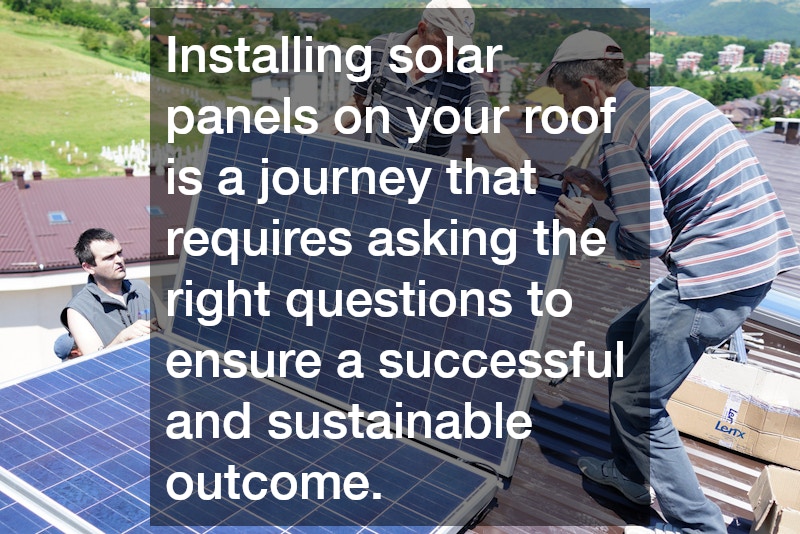Incorporating solar panels into your home’s roofing system is a significant decision that can lead to substantial energy savings and environmental benefits. However, before making this investment, it’s crucial to have a comprehensive understanding of what the process entails. One of the best ways to gain insights is by consulting with a local roofer specializing in solar panel installation. This article highlights the essential questions you should ask to make an informed decision.
1. How Compatible is My Roof for Solar Panel Installation?
1.1. Assessing Roof Structure and Condition
Before installing solar panels, it’s important to evaluate if your roof’s current structure and condition can support the addition. A professional roofer can inspect for any needed repairs or reinforcements. Ensuring your roof is capable of handling the additional weight and structure of solar panels is critical to long-term performance.
Given the fact that solar panels can last up to 25 years, your roof should preferably have a similar lifespan before installation. An inspection might reveal underlying issues like leaks or weak spots that need resolving. Addressing these issues upfront prevents future complications and unauthorized costs.
It’s vital to consider the pitch of your roof, as this can affect the angle at which panels are installed. A flat roof may require additional structures to optimize sunlight capture. Hence, a local roofer’s experience and recommendations can be incredibly valuable.
1.2. Understanding Roof Orientation and Sunlight Exposure
Determining whether your roof receives adequate sunlight involves considering its orientation and potential shading from trees or other buildings. Solar panels are most effective on roofs that face south in the Northern Hemisphere, maximizing exposure to sunlight throughout the day. Assessing this factor is essential for achieving optimal energy efficiency.
Your local roofer can utilize tools and techniques to measure sunlight exposure accurately. This analysis helps identify existing or future obstructions like tree growth or new constructions. By understanding these dynamics, you can plan the placement of solar panels more effectively for higher efficiency.
It’s not only about maximizing sunlight but also ensuring there’s minimal reflection or angle loss due to improper orientation. Seasonal changes can also affect sunlight exposure, so having flexible mounting solutions might be beneficial. A detailed evaluation of these elements will help in crafting a successful solar solution.
1.3. Identifying Roof Material and Longevity
Different roofing materials interact differently with solar panels, impacting installation techniques and durability. For instance, certain materials may require special mounts or adhesives to ensure stable installation. Rooftop material directly influences the longevity and maintenance needs of the overall solar system.
Consulting with your roofer about the material of your roof can help anticipate potential challenges. Asphalt shingles, for example, are quite compatible with solar installations, while materials like slate might need more specialized approaches. Matching the lifespan of your roof to that of solar panels is crucial for efficiency and cost-effectiveness.
Choosing the right installation method can also reduce wear and tear, prolonging both roof and panel life. Proper alignment and installation can further prevent any unnecessary weight stress. Expertise from a local roofer ensures that this installation component is managed appropriately.
2. What Are the Costs and Financial Benefits of Installing Solar Panels?
2.1. Initial Installation Costs and Incentives
Understanding the upfront costs, including labor and materials, can help you budget effectively. It’s essential to get detailed quotes that encompass the entire installation process. Additionally, inquire about potential government or local incentives that could offset costs.
Many regions offer tax rebates or incentives to encourage solar adoption, which can substantially reduce initial expenses. Consulting your local roofer ensures you understand these benefits and how to apply for them. Certain incentives might even cover part of the installation, making solar investment more attainable.
2.2. Calculating Long-Term Energy Savings
Your local roofer can provide estimates on energy savings over time, helping you assess the return on investment. By evaluating changes in electricity bills and additional maintenance costs, you can gauge the financial merits of solar installations. These predictions help determine the practicality and sustainability of adopting solar power.
Average energy savings can vary widely based on local climate and electricity rates. For instance, homes in sunnier regions tend to experience substantial bill reductions. Calculating potential savings gives you a clearer picture of long-term financial benefits.
Installing solar panels on your roof is a journey that requires asking the right questions to ensure a successful and sustainable outcome. By understanding the compatibility of your roof and the potential financial impacts, you can make an informed decision that aligns with your energy goals. Consulting a knowledgeable local roofer will give you the confidence and assurance needed to embrace solar energy effectively.
.



